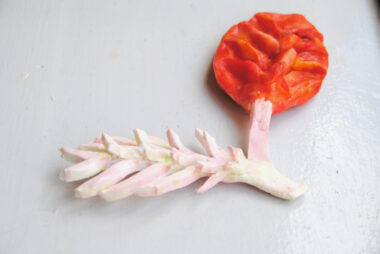How can we start a new narrative about meat?
We all know that consuming meat on a large scale is unsustainable in many ways. Still we do not collectively seem to suddenly stop eating meat. Therefore in the last years, more and more discussions, symposia and expert meetings are arranged to talk about the future of meat.
Thinking about the future of meat, generally people only see a few options.
To simply stop eating meat would be the most easy solution but since we can already just do this, apparently it is not very attractive despite the increasing number of vegans and vegetarians. Other options are producing plant based meat alternatives (see my Faked Meat project), eating insects or refining the development of lab grown meat. Others see a middle way future where we eat mostly plant based and on rare occasions eat a small portion of organic, free range meat. These discussions focus on meat but eggs and dairy are as much part of meat production as meat itself. Probably the future will be a mix of all.
Because most experts see all these options as feasible solutions for the future, most debates are about these options only, narrow down their focus and do not consider anything else.
When we look back to the past we can see that some of the tools we use and the customs we have today were absolutely unpredictable in the past. People did not expect to drive cars, use smartphones, get women to vote or eat only filets of chicken.
Plant Bones is a speculative tool that functions to facilitate reflection to challenge our minds about future meat. Plant Bones are meat-and-bone like objects in a shape and structure that resemble plant-leafs.
I ask various scientists to freely reflect on these objects and create a hypothesis on what could have happened in the future to find meat growing on plants.
Interestingly enough, many of them find very plausible answers from within their own field of expertise.
‘Some parasites that live in birds climb up in trees and attach their body to the tree and wiggle to attract birds. What if they stay on the tree when birds get extinct and evolve from there?’
‘Coral is not a plant but an animal. So these Plant bones already exist undersea?’
‘Some fungi very closely resemble meat and have a similar nutritional value. This already exists in some way.’
‘If it would be legal, synthetic biology could easily create something as plant bones.’
‘Stick insects are not very meaty but we could genetically engineer them to grow more flesh.’

Helen Kranstauber Food CabinetMarije has such a creative mindset and really enjoys every part of her work. She has the ability to work with a diverse group of people, from designers to policymakers and from farmers to entrepreneurs and food producers. Her bright ideas are very welcome to make us re-think and re-experience our relationship with food.
This is the narrative:
‘Future archeologists have found a collection of PLANT BONES.
Apparently our successors eat plants with a meat-like structure and bones.
Are they highly evolved plants, a funghi variation, genetically engineerd animals to grow as plants, a nucleair intervention or something else?
What if plant-meat has bones?’
These artifacts are similar to animal bones but are grown from vegetal cellulose.
The shape of the found objects look like plant leaves and a reconstruction proves that vegetal, meat like tissue grows around these bones.
Scientists are speculating to unravel the mystery and are investigating a series of possible scenarios to explain this botanic curiosity.
From a culinairy point of view, PLANT-BONES provide for an interesting vegan eating experience which could be already created in the present.
Plant Bones are created for
Thinking Food Design Exhibition, Paris
Curated by Earlwyn Covington at Joseph Braque Gallery
They have been on display at
Eating Design, solo exhibition at
OCT Gallery, Shenzhen
And
Bento Exhibition
Tokyo Metropolitan Art Museum
And
Design For The Senses
cooper Hewitt design Museum New York
And
Serial Eater Exhibition
Grand Hornu













